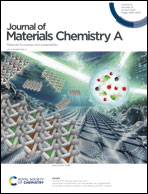Addressing the stability challenges of TiOx-based passivating contacts for high-efficiency c-Si solar cells†
Abstract
With the aid of the atomic layer deposition (ALD) technique, TiOx-based electron-selective contacts have been produced with high optical transparency and excellent passivation of silicon surfaces. These contacts are now considered to be on par with commercially available, optically absorbing Si-based contacts such as a-Si:H and poly-Si. On the other hand, these contacts have shown four stability challenges that prevent their commercialization: (1) degradation after metallization; (2) degradation following sputtering; (3) degradation over time; and (4) degradation at high temperatures. Although several approaches to overcoming some of these obstacles have been proposed in the literature, these impediments have remained unresolved over the past decade. Herein, the aforementioned problems have been successfully addressed by constructing an AlyTiOx/TiyZnOx/TiOx/ZnO/ITO multilayer structure, which includes an AlyTiOx/TiyZnOx/TiOx stack for surface passivation, an ALD ZnO buffer layer to minimize sputtering damage and hence enable recovery, and a sputtered indium tin oxide (ITO) capping layer to shield the passivation stack from moisture, act as a barrier for chlorine and hydrogen effusion, and eliminate TiOx-metal electrode interaction. Through systematic investigation, the key factors that degrade the performance of these layers are identified and resolved. This breakthrough in achieving highly stable and outstanding passivation performance using wide-bandgap transition metal oxides is a key step towards the development of highly efficient crystalline silicon (c-Si) solar cells that combine high open-circuit voltages and short-circuit current densities.



 Please wait while we load your content...
Please wait while we load your content...